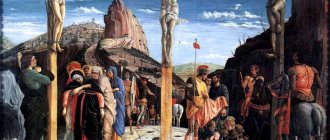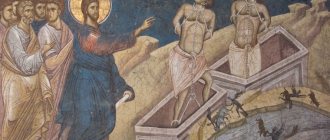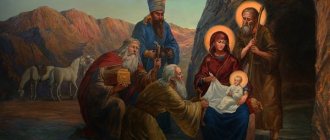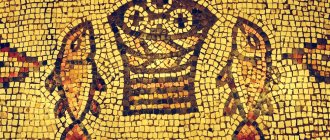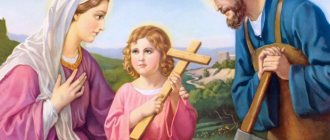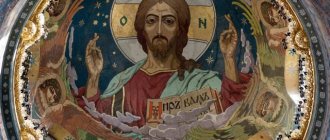Good Friday: what was Jesus Christ accused of and why was he executed?
Good or Good Friday is the most mournful day for Orthodox Christians. The Church remembers the last earthly day of Jesus Christ, who was betrayed by Judas and died crucified on the cross in agony.
1
Why was Jesus Christ crucified?
According to the Gospels, on Good Friday, Jesus Christ was brought to the highest court in Ancient Judea - the Sanhedrin. Six days earlier, the Lord raised the righteous Lazarus. The news of this instantly spread throughout Jerusalem. The Jews, expecting salvation from the Roman invaders, realized that the Messiah had appeared, conquering death. But not everyone believed in God. After the miraculous resurrection, a radical split occurred between the Jews. The Pharisees and chief priests hated Jesus and decided to kill him.
On Thursday, at the Last Supper, Christ and his disciples celebrated the Old Testament celebration of Passover - Easter. That same evening, Christ warned of his imminent death. He knew that one of his disciples would betray him, and Jesus himself would have to suffer martyrdom on the cross for human sins.
According to the Gospel, this is what happened. Christ was betrayed by Judas Iscariot. After the Last Supper, under the cover of darkness, he himself appeared to the high priests with the question of what reward they were ready for this “Whomever I kiss, he is!” - said the traitor (Matt. 26:47-49; Luke 22:47-48; Mark 14:44-45). He himself did not name the amount, so as not to sell it too cheap. It was the high priests who appointed 30 pieces of silver, wanting to humiliate Christ, because the price was equal to the value of a slave.
Jesus was captured in the Garden of Gethsemane. The Savior and his closest disciples Peter, James and John went to the garden of a small village called Gethsemane to pray to God the Father. The Lord concluded his prayer with the words: “However, not as I want, but as You want.”
Immediately, numerous guards led by a traitor student appeared in the garden with lanterns and weapons in their hands. Approaching Jesus, he said: “Hail, Teacher!” - and kissed him.
Jesus asked the soldiers who they were looking for, and heard the answer - Jesus of Nazareth.
“It is I, as if you came out against a robber with swords and stakes to take Me. Every day I was with you in the temple, teaching openly, and you did not raise your hands against Me and did not take Me, but now is your time and the power of darkness,” answered Christ.
Jesus was tied up, arrested and taken to the highest court in Ancient Judea - the Sanhedrin.
2
What was Jesus accused of?
The main accusation was that he called himself the Son of God. The high priests demanded his execution for “blasphemy.” But their words alone were not enough. The verdict had to be rendered by a representative of the Roman administration. At this time, the governor of the province of Judea was Pontius Pilate.
“I find no guilt in this man,” Pilate said.
He even decided to save Jesus through the custom of releasing one of those sentenced to death on the eve of the Jewish Passover (Passover). But the Jewish clergy could not allow Christ to be saved. They began to incite the crowd to save the robber and criminal Barabbas.
4
Why didn't Pontius Pilate free Jesus?
He feared an angry mob. The judge acquitted Barabbas, and sentenced Jesus to death by crucifixion. Such a death was considered shameful. Then Pontius Pilate washed his hands with water as a sign that he was not involved in what was happening.
The soldiers mocked Jesus and offered to save himself if he really was the King of the Jews. Jesus was first scourged, and then, wearing a red hair shirt and a crown of thorns, he was forced to carry the cross to Mount Golgotha - the Place of Execution, where He was soon crucified.
“Father! Forgive them, for they do not know what they are doing,” Christ said about his tormentors.
After Jesus was sentenced to crucifixion, Judas repented and returned the 30 pieces of silver to the high priests, saying, “I have sinned by betraying innocent blood.” They said to him: “What is that to us?” “And he threw down the pieces of silver in the temple, went out, and hanged himself” (Matthew 27:5).
5
Darkness enveloped the city...
When they arrived at the place of execution, Jesus was offered to drink wine to dull the feeling of pain. But Jesus did not accept him.
The Savior was crucified on Mount Golgotha near Jerusalem. Usually those crucified suffered on the cross for several days, but Jesus died by Friday evening.
Suddenly the sun disappeared behind the clouds. Darkness enveloped the city and the earth shook, and in the temple the curtain separating the believers from the altar was torn. So Jesus was martyred and sacrificed himself to atone for the sins of mankind.
According to legend, the body of Jesus was taken down from the cross on Friday evening with the permission of the Roman governor Pontius Pilate. The disciples of Christ, Joseph of Arimathea and Nicodemus, accompanied by the Mother of God and the myrrh-bearing women, carried the Savior who died on the cross in their arms. They walked from Mount Golgotha to Joseph's vineyard, where there was a burial cave. According to Jewish custom, the body of Jesus was placed in it. A large stone was rolled against the door of the coffin.
Judas Iscariot After Jesus Christ was sentenced to crucifixion, Judas repented and returned the 30 pieces of silver to the high priests and elders, saying: “I have sinned by betraying innocent blood.” They said to him: “What is that to us?”
6
How is the service held on this day and why is there no communion?
It is customary to spend the most mournful day in prayer; it is recommended to attend a service in the temple. But this year, due to the coronavirus pandemic, it is recommended to watch services online.
On the day of the Savior’s suffering and death on the cross, no liturgy is celebrated, because communion is considered a joyful event for Christians. On Good Friday the Royal Hours service takes place. This service is unusual, it is performed only once a year.
Usually at 14-15 o'clock the shroud is brought to the center of the temple - an icon embroidered on fabric or printed, the main subject of which is the position of Jesus Christ in the tomb. According to ancient Jewish custom, the Savior, before being laid in the tomb, was washed with aromatic oils and wrapped in funeral cloth - the shroud.
After this, the canon about the crucifixion of the Lord and the lamentation of the Most Holy Theotokos is read, then the parishioners of the temple venerate the shroud.
The Shroud remains in the same place until the evening of Holy Saturday.
7
What should you not eat on Good Friday? Good Friday is the strictest day of Lent. Before sunset, believers do not eat anything or adhere to dry eating. Fruits, vegetables, bread, water are allowed. Fish, meat, butter, milk, eggs, alcohol are prohibited.
8
What should you not do on Good Friday?
On Good Friday it is forbidden to be angry or swear. Singing songs, dancing and having fun is prohibited. On this day it is not recommended to do work in the garden. It is believed that then there will be no harvest.
If you cannot put off work, then the clergy recommend doing it with the thought of the crucifixion and suffering of Jesus Christ on the cross.
The only exception to this work is that you can bake Easter eggs and paint eggs. But this can only be done on an empty stomach and after praying the Lord’s Prayer.
https://www.amic.ru/news/
Who did the Romans crucify instead of Jesus?
The events surrounding the last days of Isa, the son of Maryam, peace to both of them, on earth are shrouded in mystery. In the four canonized Gospels we read that Jesus was crucified on Calvary, outside the city walls of Jerusalem (Matt. 27:33-38, Mark 15:22-27, Luke 23:33-43, John 19:17-25 ).
The idea of Christ's sacrifice on the cross occupies a central place in Christian doctrine, and apologists of Christianity react painfully to any attempts to question the historicity of Christ's crucifixion. Hence the attitude towards the so-called Gospel of Barnabas, which reports that instead of Jesus, Judas Iscariot was executed, who at the time of his arrest took on the appearance of a Teacher, and Jesus himself was saved by angels and ascended to the third heaven. This document has been known since at least the 16th century and is only partially preserved and its authorship cannot be proven. However, at the Second Vatican Council (1962-1965), the church admitted that the authors of the canonical Gospels are also unknown. In other words, we do not know which church fathers wrote the texts that describe the crucifixion of Jesus, and there is no archaeological or other evidence of this event. Meanwhile, Muslims believe that Prophet Isa was not killed and was not crucified , and let's see what the Holy Quran says about this.
In the Koran, a special place is given to the story of the mother of Jesus - Mary, or Maryam, as she is called in the Koran. It also describes Jesus' virgin birth and birth, his first miracle when he spoke and interceded for his mother while still an infant. Among his other miracles, the meal that Allah sent down from heaven to the apostles of Jesus is mentioned. The Qur'an also speaks of Jesus' ascension to heaven and the controversy surrounding his ascension, and contains references to his second coming to earth. That is, the prophecy of Jesus is considered the most important milestone in the history of mankind and from the point of view of Islam. Prophet Muhammad, peace and blessings of Allah be upon him, also said that there were no other prophets between him and Isa [Abu Dawud 4324].
As for the crucifixion of Christ, we read in the Koran: “But they did not kill him and did not crucify him, but this only appeared to them” (Sura 4 “Women”, verse 157)
. That is, the Koran categorically denies any claims that Jesus was killed or crucified. But what do the words “and it just seemed to them” mean?
Unfortunately, the statements of the Prophet Muhammad, peace and blessings of Allah be upon him, which would shed light on the events of that day, have not reached us. Perhaps he told his companions about this, or perhaps they were content with what had already been said in the Koran, without going into details. There were almost no Christians surrounded by the first Muslims. Many Jews lived next door to them in Medina, but there were almost no Christians, which means there was no controversy about the crucifixion of Christ. And when a delegation of Christians from Najran arrived in Medina, the question of the nature of Christ was discussed, and not about his crucifixion.
Be that as it may, in the absence of prophetic hadiths about what exactly happened that day to the prophet Isa, peace be upon him, commentators on the Quran asked Christian and Jewish scholars with whom they met about this. These traditions are preserved in early Muslim sources and are of great interest for understanding early Christianity.
Thus, Imam at-Tabari in his tafsir gives several versions, and their essence boils down to the fact that when Roman soldiers surrounded the house in which Jesus was with his apostles, Allah changed his appearance, and his appearance was given to another person, whom and the soldiers grabbed him. Some legends say that Jesus’ appearance was given to everyone present in that house at once, while others say that Jesus’ appearance was accepted only by one of the apostles, who voluntarily volunteered to die in the Teacher’s place. Whether it was true or not, we have no clear knowledge of this, and the Koran requires us only to believe that Jesus was not crucified and was not killed. Moreover, the high priests and scribes, who demanded that the Romans execute Jesus, realized that something had not gone the way they wanted. They noticed that the man who was captured by the soldiers had a different build from Jesus. And when he was crucified, they realized that it was not Jesus. The Koran says this: “They were not sure that they were killing him” (Sura 4 “Women”, verse 157)
.
Thus, we know for sure that the Jewish plan was unsuccessful and the Roman soldiers were unable to capture Jesus. Something amazing happened, and instead of the Prophet of Allah, the soldiers captured another person, probably one of his apostles. The Jews realized that something strange had happened, and when the man was killed, they were not sure that it was Jesus. Meanwhile, Allah Almighty ascended Jesus himself to heaven. This was a bodily ascension, but we do not know exactly what state Jesus was in: whether he was asleep or awake. The Koran says in this regard: “O Isa, I will take your soul and lift you to Myself” (Sura 3 “The Family of Imran”, verse 55)
.
And in another place the Koran says through the mouth of the prophet Isa: “And after You took my soul, You watched over them. You are Witness to everything” (Sura 5 “The Meal”, verse 117)
.
The verb tawaffa, which appears in these two verses, was not easy to translate. Many years ago, while working on the translation of tafsir, I agreed with the “put to rest” option proposed by academician I. Yu. Krachkovsky. This is a good option, because depending on the context, the word “put to rest” can take on additional connotations. However, later I abandoned it and translated the verse from the surah “The Family of Imran”: “I will take your soul.” In Russian there is also the word “to finish”, and it is very close in meaning to the verb tawaffa, but is not at all suitable for this context. Therefore, I settled on the option “to take the soul”, especially since in the Koran the verb tawaffa is used in the meaning “to put to sleep” (Sura 6 “Cattle”, verse 60)
, “to kill”
(Sura 6 “Cattle”, verse 61)
, “to take the soul”
(Sura 39 “Crowds”, verse 42)
. That is, the word wafat can mean “death” or “sleep”, and in both cases we are talking about the fact that the Almighty takes away a person’s soul, in whole or in part.
What type of wafat is meant when we talk about the ascension of the prophet Isa? Some commentators believed that it was a dream, that is, Allah put him into sleep and in this state took him to heaven. Others believed that in the verse, “O Jesus, I will take your soul and lift you up to Myself,” there was a deliberate change in the order of words in order to draw attention to the importance of the subject matter. That is, first the prophet Isa was ascended to heaven, and then Allah will take his soul, and this will happen after his second coming.
There is another opinion that does not take into account the semantics of the verb tawaffa. It follows from it that the words إِنِّي مُتَوَفِّيكَ وَرَافِعُكَ إِلَيَّ mean “I will take you and lift you to Myself,” that is, I will simply take you from the earth, without any sleep or death. This opinion was preferred by Imam at-Tabari. But I chose to translate “I will take your soul” because the translation of “I will take you” leaves no room for interpretation. My method of translating the Quran is that if a verse has different interpretations, if early commentators understood it differently, then this should be reflected in the translation. Of course, if it works out. But it doesn’t always work out. And then you have to point out these different opinions in the comments.
